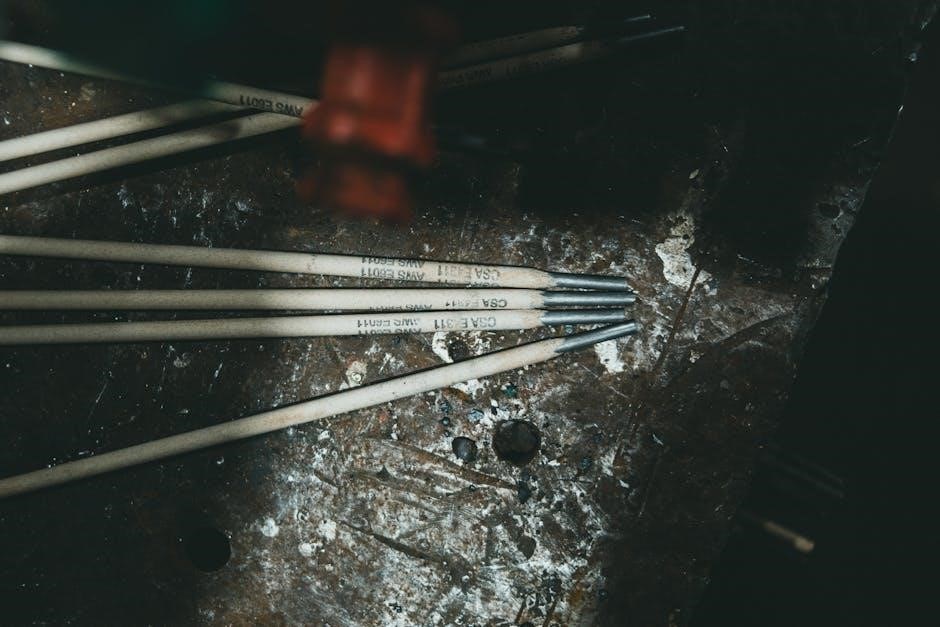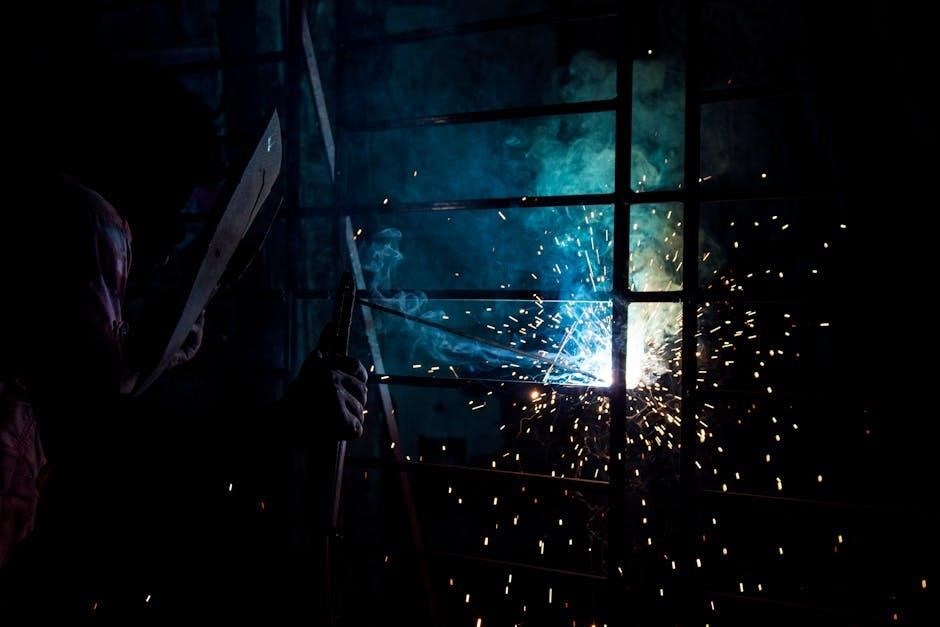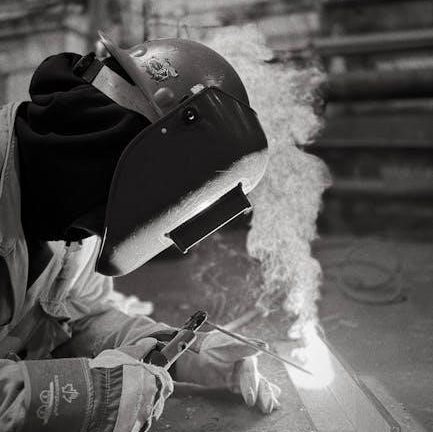Welding electrodes are critical consumables in welding processes, available in various types like mild steel, stainless steel, and low alloy, classified to ensure compatibility and optimal performance in different applications․
1․1 Definition and Purpose of Welding Electrodes
Welding electrodes are consumable components used in welding processes to conduct electrical current and form the weld․ They are classified into types like mild steel, stainless steel, and low alloy, each designed for specific applications․ The AWS classification system assigns codes based on tensile strength, position usage, and coating type, ensuring compatibility with base metals and processes․ Electrodes are crucial for achieving desired mechanical properties, such as strength and durability, in welded joints, making them essential for structural integrity and quality in welding operations across industries․
1․2 Importance of Electrode Classification
Electrode classification is essential for ensuring compatibility with base metals and welding processes, guaranteeing weld quality and safety․ The AWS system assigns specific codes, providing information on tensile strength, position usage, and coating type․ This classification helps prevent material mismatches and ensures mechanical properties like strength and durability․ Proper selection based on classification minimizes defects and enhances weld reliability, making it critical for structural integrity in applications like construction and manufacturing, where safety and durability are paramount․

AWS Classification System
The AWS classification system standardizes welding electrodes, ensuring consistency and quality․ It provides detailed codes like E6010, guiding selection based on tensile strength, position, and shielding gas requirements, enhancing applicability․
2․1 Overview of AWS Welding Electrode Classification
The AWS welding electrode classification system provides standardized codes for electrodes, ensuring consistent manufacturing and application․ These codes, like E7018, indicate specific weld properties, enabling precise selection based on tensile strength and shielding requirements․ The system ensures quality, compatibility, and repeatability in welding processes, making it a critical resource for welders․ The classification guides electrode usage across various welding techniques, optimizing joint strength and durability․ Its universal adoption facilitates easy identification and selection of electrodes for diverse industrial applications․
2․2 Key Parameters in AWS Classification
The AWS classification system evaluates electrodes based on tensile strength, weld position capabilities, and shielding types․ Parameters include yield strength, elongation, and impact resistance, ensuring electrodes meet specific mechanical property requirements․ Shielding types, such as rutile or basic, determine slag characteristics and weld penetration․ Positional capabilities (flat, vertical, overhead) are also specified, enabling appropriate electrode selection for diverse welding applications․ These parameters guide welders in achieving desired joint integrity and mechanical performance across various industries and projects․
2․3 AWS Specifications for Electrodes (e․g․, A5․1, A5․2)
AWS specifications like A5․1 and A5․2 define the testing, chemical composition, and mechanical properties of welding electrodes․ A5․1 covers carbon steel electrodes, while A5․2 focuses on magnesium alloy electrodes․ These standards ensure electrodes meet specific strength, ductility, and corrosion resistance requirements․ They also detail proper packaging, labeling, and storage to maintain electrode quality․ Adhering to these specifications guarantees consistent weld quality and performance across various applications, making them essential for welders and engineers․ These standards are regularly updated to reflect advancements in welding technology and materials․
Types of Welding Electrodes
Welding electrodes come in various types, each designed for specific applications․ Common materials include mild steel, stainless steel, and low alloy steel․ Electrodes vary in composition and performance to suit different welding needs and desired weld properties․
3․1 Mild Steel Electrodes (E7018, E7024)
Mild steel electrodes, such as E7018 and E7024, are widely used for welding low-carbon steel․ E7018 is known for deep penetration and high mechanical strength, making it ideal for structural applications․ E7024, on the other hand, offers excellent usability with a smooth, stable arc and minimal spatter․ Both electrodes are versatile and suitable for various welding positions, including flat, vertical, and overhead․ They are commonly referenced in welding electrode charts for their reliable performance in construction and fabrication projects․
3․2 Stainless Steel Electrodes (E308, E316)
Stainless steel electrodes like E308 and E316 are designed for welding corrosion-resistant steels․ E308 offers balanced chromium-nickel content for general-purpose stainless steel welding, while E316 contains molybdenum for enhanced resistance to pitting and crevice corrosion․ These electrodes are widely used in food processing, chemical plants, and marine applications․ They are detailed in welding electrode charts for their suitability in various environments requiring durability and resistance to corrosive elements․
3․3 Low Alloy Steel Electrodes (E8018, E9018)
Low alloy steel electrodes, such as E8018 and E9018, are designed to weld high-strength, low-alloy steels․ E8018 is commonly used for structural welding, offering excellent toughness and resistance to cracking․ E9018 is ideal for high-strength applications, providing superior mechanical properties․ These electrodes are detailed in welding electrode charts, highlighting their suitability for construction, heavy machinery, and industrial equipment․ They ensure strong, durable welds in demanding environments, making them essential for specific alloy steel welding requirements․

Welding Processes and Electrode Compatibility
This section explores welding processes like SMAW, GMAW, and GTAW, focusing on electrode compatibility to ensure optimal weld quality and process efficiency and performance․
4․1 Shielded Metal Arc Welding (SMAW)
Shielded Metal Arc Welding (SMAW) is a widely used process employing a consumable electrode covered in flux․ It is ideal for manual welding in various positions due to its portability․ SMAW electrodes, such as E7018 and E6013, are selected based on the base metal type and desired weld properties․ The flux coating protects the arc, stabilizes the weld pool, and absorbs impurities․ SMAW is versatile, suitable for steel, stainless steel, and cast iron, making it a popular choice in construction, repair, and maintenance applications․ Proper electrode storage and handling are critical for optimal performance․
4․2 Gas Metal Arc Welding (GMAW)
Gas Metal Arc Welding (GMAW) uses a continuous wire electrode fed through a welding gun, producing high-speed, clean welds․ Common GMAW electrodes include ER70S-6 for steel and ER308L for stainless steel․ Shielding is provided by inert gases like argon or argon-co2 mixtures․ GMAW is highly efficient, suitable for thin materials, and offers excellent penetration․ It excels in automotive, fabrication, and high-volume production․ GMAW requires proper gas flow and wire feed settings for consistent results, making it ideal for precision and controlled environments․
4․3 Gas Tungsten Arc Welding (GTAW)
Gas Tungsten Arc Welding (GTAW) uses a non-consumable tungsten electrode, offering precise control and high-quality welds․ Common electrodes include pure tungsten and thoriated types․ Shielding gases like argon or helium protect the weld․ GTAW excels in thin materials, stainless steel, and aluminum, providing clean, slag-free joints․ It is widely used in aerospace, automotive, and orbital welding․ GTAW requires skill for consistent results, making it ideal for critical applications requiring minimal distortion and maximum weld integrity․

Electrode Coating and Current Type
Electrode coatings (cellulosic, rutile, basic) influence weld penetration and slag formation․ Current types (AC/DC) affect weld penetration and electrode performance, optimizing weld quality and process efficiency․
5․1 Types of Coatings (Cellulosic, Rutile, Basic)
Cellulosic coatings produce welds with deep penetration and fast-freezing slag, ideal for Shielded Metal Arc Welding (SMAW)․ Rutile coatings offer smoother welds, easier slag removal, and are versatile for various welding processes․ Basic coatings enhance mechanical properties like strength and toughness, typically used with DC current․ Each coating type caters to specific welding needs, ensuring optimal performance and weld quality․ Understanding these coatings aids in selecting the right electrode for desired outcomes․
5․2 DC vs․ AC Current for Electrodes
Direct Current (DC) provides consistent welding current, offering better control and deeper penetration, especially with rutile and basic coatings․ Alternating Current (AC) alternates direction, reducing arc blow and improving weld cleanliness, ideal for cellulosic electrodes․ DC is preferred for most SMAW applications, while AC is better suited for thin materials or specific electrode types․ Choosing the right current type depends on the electrode coating and desired weld properties, ensuring optimal performance and quality․

Electrode Selection Criteria
Electrode selection depends on base metal type, thickness, welding position, and desired mechanical properties․ Each factor ensures compatibility, penetration, and strength for optimal welding results․
6․1 Base Metal Type and Thickness
Base metal type and thickness are critical in selecting the right electrode․ For example, E7018 is ideal for thick steel plates, while E308 is suited for stainless steel․ The welding electrode chart PDF provides a detailed cross-reference, helping welders match electrodes to specific base metals and thicknesses․ This ensures proper penetration, strength, and compatibility, minimizing defects and ensuring weld integrity․ Always refer to the chart for precise recommendations based on your project’s requirements․
6․2 Welding Position (Flat, Vertical, Overhead)
The welding position significantly influences electrode selection․ Flat welding allows for easier control, while vertical and overhead positions require electrodes with better slag removal and reduced spatter․ The welding electrode chart PDF provides guidance on electrode suitability for different positions, ensuring proper weld penetration and quality․ For example, certain electrodes excel in vertical or overhead applications due to their arc stability and low spatter characteristics, making the chart an essential tool for optimizing weld quality and efficiency․
6․3 Desired Mechanical Properties
Selecting electrodes based on desired mechanical properties ensures optimal weld quality․ The welding electrode chart PDF helps match electrodes to required properties like tensile strength, toughness, and corrosion resistance․ For instance, electrodes for high-strength steel ensure superior tensile strength, while those for corrosion-resistant applications prioritize chemical resistance․ Understanding these properties allows welders to choose electrodes that meet specific project demands, ensuring durability and performance in the final weld joint․

Comparative Electrode Charts
These charts compare AWS and ISO classifications, offering cross-references and manufacturer-specific equivalents, ensuring compatibility and meeting project specifications for welders and engineers․
7․1 Cross-Reference of AWS and ISO Classifications
A welding electrode chart PDF provides a detailed cross-reference between AWS and ISO classifications, ensuring compatibility and equivalency․ This resource helps welders match electrodes like E7018 (AWS) with ISO counterparts, streamlining global projects․ It highlights chemical composition, mechanical properties, and usage parameters, reducing confusion and ensuring adherence to international standards․ By aligning these classifications, professionals can select the right electrodes for their applications, avoiding mismatches and improving weld quality․ This cross-reference is essential for maintaining consistency across diverse welding operations worldwide․
7․2 Manufacturer-Specific Electrode Equivalents
A welding electrode chart PDF often includes manufacturer-specific equivalents, aiding in electrode selection across brands․ These charts list alternative electrodes from different manufacturers that match AWS or ISO standards․ For example, a chart might show equivalents for E7018 or E308 from various suppliers․ This ensures compatibility and consistency, even when using electrodes from different manufacturers․ It also helps in procurement and reduces delays when a specific brand is unavailable․ Always refer to the chart for precise equivalency to maintain weld quality and integrity․

Applications of Welding Electrodes
Welding electrodes are used in structural steel, pipelines, and marine applications, ensuring strong, durable joints․ They are essential for construction, automotive, and industrial repairs, providing reliable weld quality․
8․1 Structural Steel Welding
Structural steel welding relies on electrodes like E7018 and E7024 for high-strength, low-alloy steels․ These electrodes ensure strong, ductile welds in beams, columns, and high-rise buildings․ They provide excellent tensile strength and resistance to cracking, making them ideal for load-bearing applications․ Proper electrode selection, based on the welding electrode chart, ensures compatibility with base metals and meets design specifications․ Fabrication of structural components requires precise joint preparation and shielding to maintain weld integrity and durability in harsh environments․
8․2 Pipeline Welding
Pipeline welding requires electrodes that ensure high integrity and corrosion resistance in demanding environments․ Electrodes like E7010 and E7020 are commonly used for their deep penetration and toughness․ They are suitable for welding high-strength, low-alloy steels in oil and gas pipelines․ Proper electrode selection from the welding electrode chart ensures compliance with API and ASME standards, providing reliable joints that withstand pressure and environmental stresses, crucial for maintaining pipeline safety and longevity․
8․3 Shipbuilding and Marine Applications
In shipbuilding, welding electrodes must withstand harsh marine environments and corrosion․ Stainless steel electrodes like E308 and E316 are widely used for their corrosion resistance and durability in seawater․ Electrodes with high toughness, such as E6013 and E7016, are also employed for structural integrity․ The welding electrode chart aids in selecting the right electrodes for marine-grade steels, ensuring compliance with classification societies like ABS and DNV GL․ Proper electrode choice is critical for building seaworthy vessels that endure saline conditions and mechanical stress over time․
Safety and Handling of Electrodes
Proper handling involves using tongs or dry, insulated pliers to avoid moisture absorption and electrical hazards․ Always wear protective gloves and goggles to prevent injuries․
9․1 Proper Storage and Drying of Electrodes
Electrodes must be stored in a cool, dry place to prevent moisture absorption․ Use sealed containers or resealable bags to maintain humidity control․ For electrodes that require drying, bake them in a heated oven at 250-300°F for 1-2 hours․ Always follow the manufacturer’s drying instructions to avoid damage․ Proper storage ensures optimal welding performance and prevents defects․ Refer to welding electrode charts for specific drying requirements and storage recommendations to maintain electrode quality and longevity․ This step is critical for achieving consistent weld quality and durability․
9․2 Safety Precautions for Handling Welding Electrodes
Always wear insulated gloves and safety glasses when handling welding electrodes to prevent electric shock and eye damage․ Avoid touching the electrode tip with bare hands to maintain its integrity․ Keep the work area clean and well-ventilated to reduce fume exposure․ Store electrodes in a dry, secure location away from flammable materials․ Follow manufacturer guidelines for handling and disposal to ensure safety and compliance with regulations․ Proper handling prevents accidents and ensures reliable welding performance․

Troubleshooting Common Electrode Issues
Identify and address issues like porosity, lack of fusion, or slag inclusion by adjusting technique, shielding gas, or electrode angle․ Ensure proper electrode storage and handling․
10․1 Porosity and Lack of Fusion
Porosity and lack of fusion are common welding defects caused by improper shielding gas flow, incorrect electrode angle, or contaminated base metal․ These issues can lead to weak welds․ To resolve porosity, ensure proper gas flow rates and clean the base metal thoroughly․ Lack of fusion often results from insufficient heat input or incorrect electrode technique․ Adjusting the welding parameters, such as voltage and current, and maintaining proper joint preparation can help achieve full fusion․ Referencing a welding electrode chart PDF can guide electrode selection and optimal settings to minimize these defects and improve weld quality․
10․2 Slag Inclusion and Electrode Spatter
Slag inclusion occurs when slag remains trapped in the weld, weakening its integrity․ Electrode spatter happens when molten metal particles scatter, creating an uneven surface․ Both issues are often caused by improper electrode angle, insufficient shielding gas, or incorrect polarity․ To address these, ensure the welding area is clean, adjust the electrode technique, and maintain proper gas flow․ Using the right electrode type, as specified in a welding electrode chart PDF, can minimize spatter and slag entrapment, improving weld quality and appearance․

Future Trends in Welding Electrodes
Future trends include eco-friendly electrodes, advanced coatings, and sustainable materials, reducing environmental impact while enhancing weld quality and efficiency, as highlighted in welding electrode chart PDFs․
11․1 Advanced Coating Technologies
Advanced coating technologies are revolutionizing welding electrodes, offering improved weld penetration, corrosion resistance, and mechanical properties․ Nano-materials and multi-layer coatings enhance performance, enabling tailored solutions for specific applications․ These innovations, detailed in welding electrode chart PDFs, focus on sustainability and efficiency, reducing environmental impact while maintaining high-quality welds․ Eco-friendly coatings and biodegradable options are gaining traction, aligning with global environmental regulations and industry demands for greener practices․
11․2 Sustainability and Eco-Friendly Electrodes
The welding industry is shifting toward eco-friendly electrodes to minimize environmental impact․ These electrodes reduce harmful emissions and toxic elements, aligning with global sustainability goals․ Innovations include low-VOC (volatile organic compound) coatings and electrodes made from recycled materials․ Some manufacturers are developing biodegradable coatings, reducing waste and environmental harm․ These advancements are detailed in welding electrode chart PDFs, emphasizing their compatibility with modern welding processes and compliance with environmental regulations like AWS A5․36 for sustainable practices․

Resources for Welding Electrode Charts
- AWS Publications: Access electrode charts in AWS standards like A5․1/A5․1M․
- Manufacturer Websites: Many suppliers provide PDF charts for their electrodes․
- Online Databases: Platforms like Welding Handbook offer downloadable electrode charts․
12․1 AWS Publications and Standards
The American Welding Society (AWS) provides comprehensive publications and standards for welding electrode charts․ These resources include detailed electrode specifications, classifications, and usage guidelines․ AWS A5․1/A5․1M covers shielded metal arc welding electrodes, while A5․2/A5․2M focuses on flux cored electrodes․ These standards offer charts and tables to help select the right electrode for specific applications․ They also include information on mechanical properties, chemical composition, and recommended welding techniques․ AWS publications are available in PDF format on their official website or through authorized distributors․
12․2 Online Databases and PDF Guides
Online databases and PDF guides provide accessible resources for welding electrode charts․ Websites like AWS and ASME offer downloadable PDFs with detailed electrode specifications․ These guides include charts for electrode classification, chemical composition, and mechanical properties․ Many manufacturers, such as Lincoln Electric and Hobart Brothers, also provide free PDF guides․ These resources are updated regularly to reflect industry standards and advancements, ensuring welders have accurate information for electrode selection and application․
13․1 Summary of Key Points
A welding electrode chart PDF serves as a critical resource for selecting the right electrodes, ensuring compatibility with base metals and welding processes․ It standardizes electrode classifications, such as AWS and ISO designations, and provides insights into coatings, current types, and mechanical properties․ These charts are essential for achieving optimal weld quality, reducing defects like porosity or slag inclusions, and meeting specific industry requirements․ Referencing updated charts ensures adherence to safety standards and enhances welding efficiency across various applications․
13․2 Final Thoughts on Electrode Selection and Use
Welding electrode charts are invaluable for ensuring proper electrode selection and use․ They guide welders in matching electrodes to base metals, processes, and desired outcomes, minimizing errors and improving weld quality․ Always refer to updated charts and manufacturer guidelines for optimal results․ Proper electrode handling, storage, and usage are critical for safety and efficiency․ By adhering to these practices, welders can achieve consistent, high-quality welds across various applications and industries․

